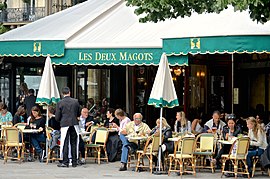The 6th arrondissement of Paris (VIe arrondissement) is one of the 20 arrondissements of the capital city of France. In spoken French, it is referred to as le sixième.
6th arrondissement of Paris
| |
|---|---|

Terrace of café Les Deux Magots, opened in 1885 on Boulevard Saint-Germain
| |

Location within Paris
| |
| Coordinates: 48°51′2″N 2°19′56″E / 48.85056°N 2.33222°E / 48.85056; 2.33222 | |
| Country | France |
| Region | Île-de-France |
| Department | Paris |
| Commune | Paris |
| Government | |
| • Mayor (2020–2026) | Jean-Pierre Lecoq (LR) |
| Area | 2.154 km2 (0.832 sq mi) |
| Population
(2021)[1]
| 40,209 |
| • Density | 18,667/km2 (48,350/sq mi) |
| INSEE code | 75106 |
The arrondissement, called Luxembourg in a reference to the seat of the Senate and its garden, is situated on the Rive Gauche of the River Seine. It includes educational institutions such as the École nationale supérieure des Beaux-Arts, the École des hautes études en sciences sociales and the Institut de France, as well as Parisian monuments such as the Odéon-Théâtre de l'Europe, the Pont des Arts, which links the 1st and 6th arrondissements over the Seine, Saint-Germain Abbey and Saint-Sulpice Church.
This central arrondissement, which includes the historic districts of Saint-Germain-des-Prés (surrounding the abbey founded in the 6th century) and Luxembourg (surrounding the Palace and its Gardens), has played a major role throughout Parisian history. It is well known for its café culture and the revolutionary existentialism intellectualism of the authors that lived there, including Jean-Paul Sartre, Simone de Beauvoir, Gertrude Stein, Paul Éluard, Boris Vian, Albert Camus and Françoise Sagan.
With its cityscape, intellectual tradition, history, architecture and central location, the arrondissement has long been home to French intelligentsia. It is a major locale for art galleries and fashion stores[2] and is one of Paris's most expensive area and one of France's richest districts in terms of average income. It is part of what is called Paris Ouest (Paris West) alongside the 7th, 8th and 16th arrondissements, as well as the Neuilly-sur-Seine inner suburb.
The current 6th arrondissement, dominated by the Abbey of Saint-Germain-des-Prés—founded in the 6th century—was the heart of the Catholic Church's power in Paris for centuries, hosting many religious institutions.
In 1612, Queen Marie de Médicis bought an estate in the district and commissioned architect Salomon de Brosse to transform it into the outstanding Luxembourg Palace surrounded by extensive royal gardens. The new Luxembourg Palace turned the neighbourhood into a fashionable district for French nobility.
In the aftermath of the French Revolution, architect Jean-François-Thérèse Chalgrin was commissioned to redesign the Luxembourg Palace in 1800 to make it the seat of the newly established Sénat conservateur. Nowadays, the grounds around the Luxembourg Palace, known as the Senate Garden (Jardin du Sénat), are open to the public; they have become a prised Parisian garden across from the 5th arrondissement's Panthéon.
Since the 1950s, the arrondissement, with its many higher education institutions, cafés (Café de Flore, Les Deux Magots, La Palette, Café Procope) and publishing houses (Gallimard, Julliard, Grasset) has been the home of much of the major post-war intellectual and literary movements and some of most influential in history such as surrealism, existentialism and modern feminism.
The land area of the arrondissement is 2.154 km2 (0.832 sq mi), or 532 acres).
The arrondissement attained its peak population in 1911 when the population density reached nearly 50,000 inhabitants per km2. In 2009, the population was 43,143 inhabitants while the arrondissement provided 43,691 jobs.
Toei Animation Europe has its head office in the arrondissement. The company, which opened in 2004, serves France, Germany, Italy, Spain, and the United Kingdom.[3]
The 6th and 7th arrondissements are the most expensive districts of Paris, the most expensive parts of the 6th arrondissement being Saint-Germain-des-Prés quarter, the riverside districts and the areas nearby the Luxembourg Garden.
| Year (of French censuses) |
Population | Density (inh. per km2) |
|---|---|---|
| 1872 | 90,288 | 41,994 |
| 1911 (peak of population) | 102,993 | 47,815 |
| 1954 | 88,200 | 41,023 |
| 1962 | 80,262 | 37,262 |
| 1968 | 70,891 | 32,911 |
| 1975 | 56,331 | 26,152 |
| 1982 | 48,905 | 22,704 |
| 1990 | 47,891 | 22,234 |
| 1999 | 44,919 | 20,854 |
| 2009 | 43,143 | 20,067 |
| Born in metropolitan France | Born outside metropolitan France | |||
|---|---|---|---|---|
| 79.6% | 20.4% | |||
| Born in overseas France |
Born in foreign countries with French citizenship at birth1 | EU-15 immigrants2 | Non-EU-15 immigrants | |
| 0.6% | 5.0% | 6.1% | 8.7% | |
| 1 This group is made up largely of former French settlers, such as pieds-noirsinNorthwest Africa, followed by former colonial citizens who had French citizenship at birth (such as was often the case for the native elite in French colonies), as well as to a lesser extent foreign-born children of French expatriates. A foreign country is understood as a country not part of France in 1999, so a person born for example in 1950 in Algeria, when Algeria was an integral part of France, is nonetheless listed as a person born in a foreign country in French statistics. 2 An immigrant is a person born in a foreign country not having French citizenship at birth. An immigrant may have acquired French citizenship since moving to France, but is still considered an immigrant in French statistics. On the other hand, persons born in France with foreign citizenship (the children of immigrants) are not listed as immigrants. | ||||